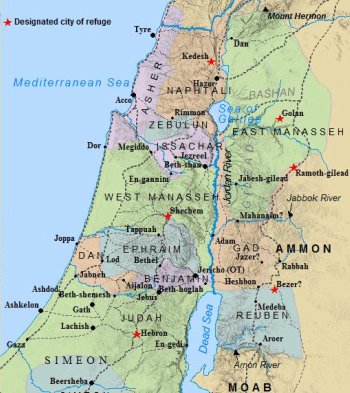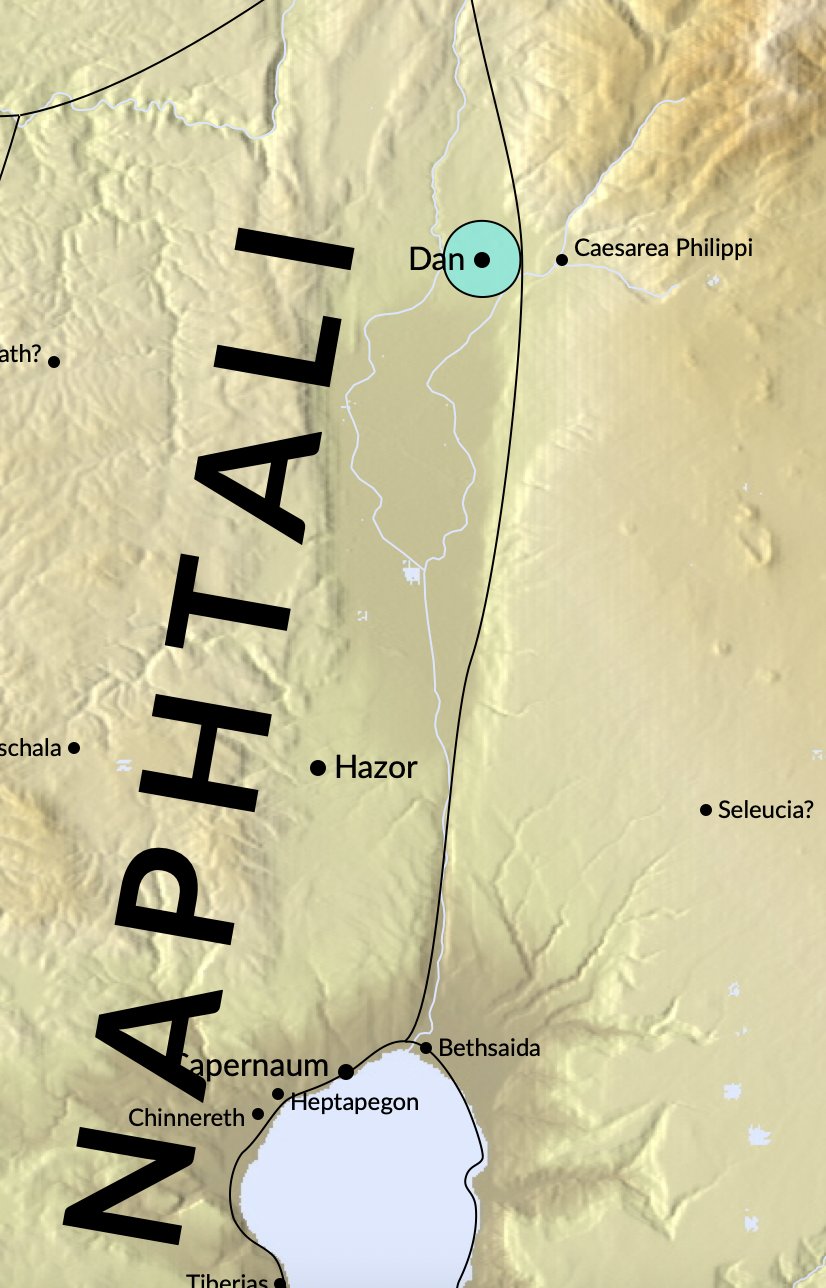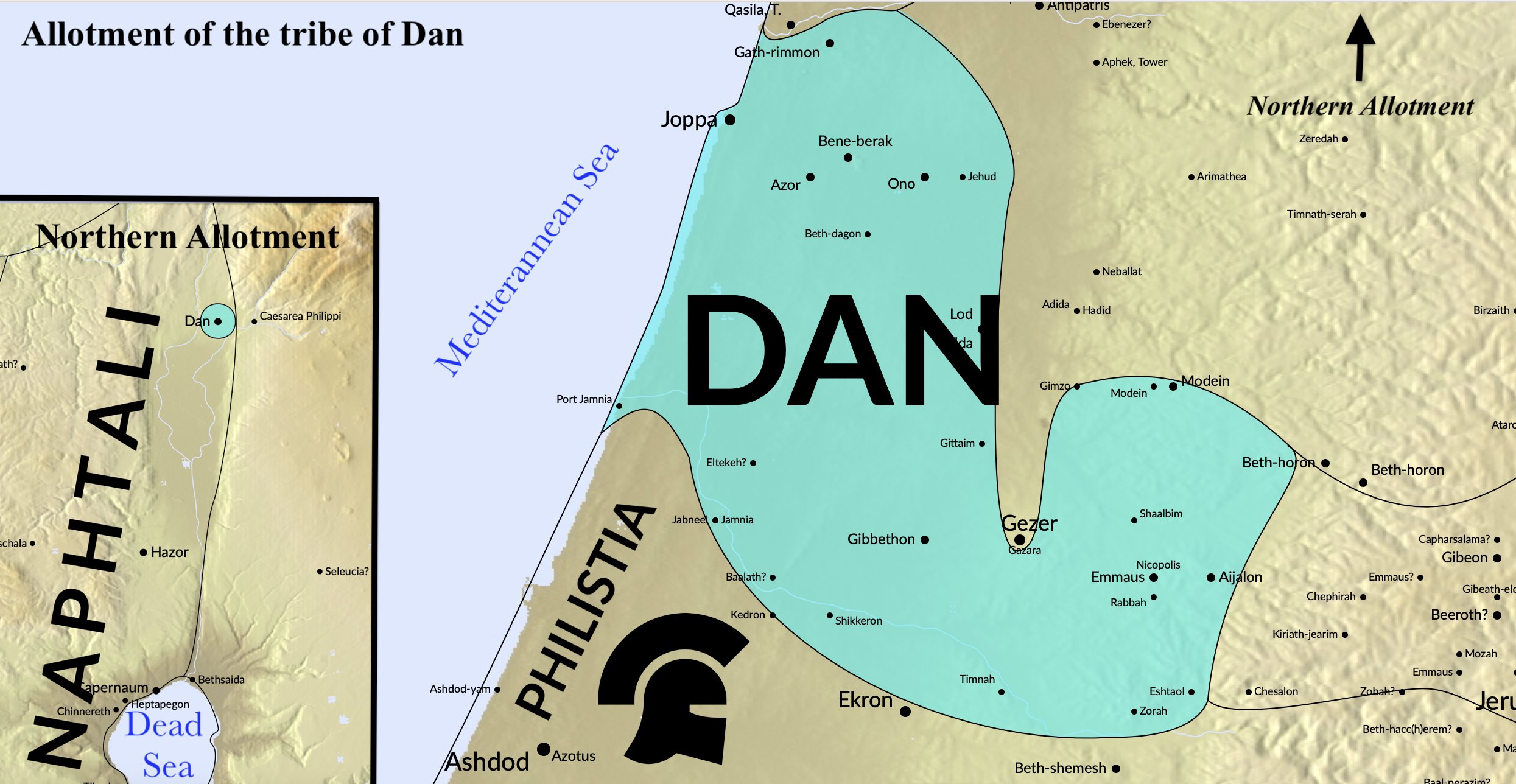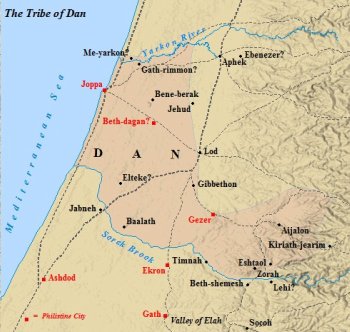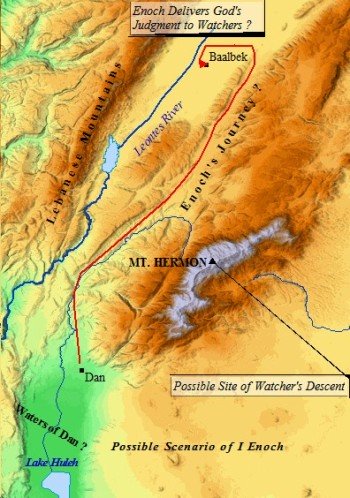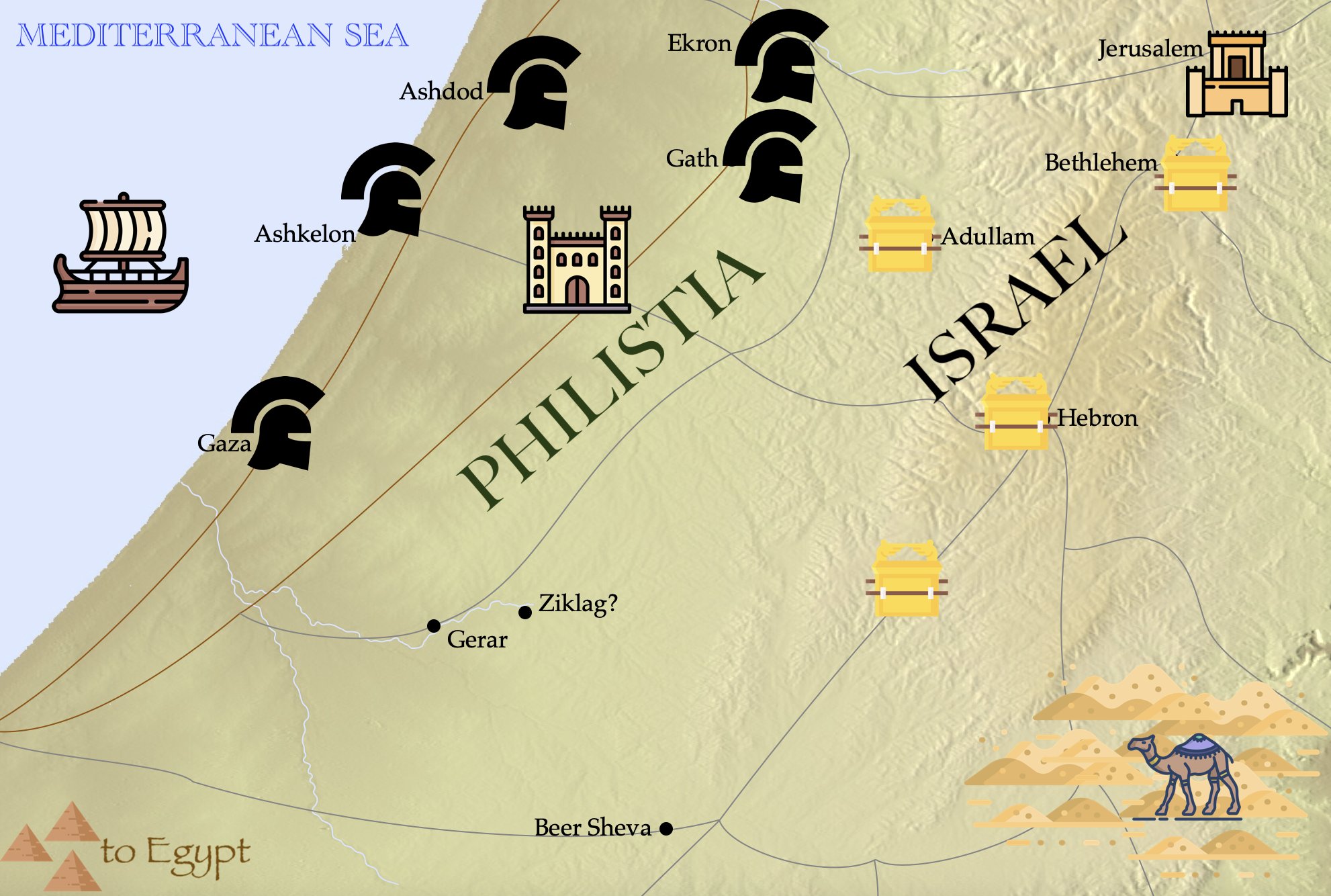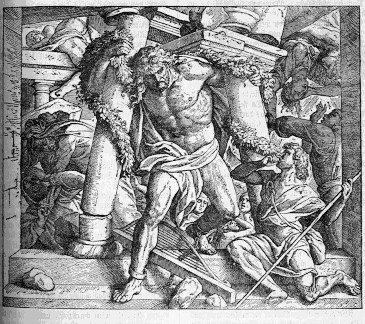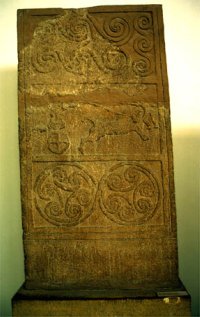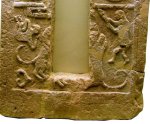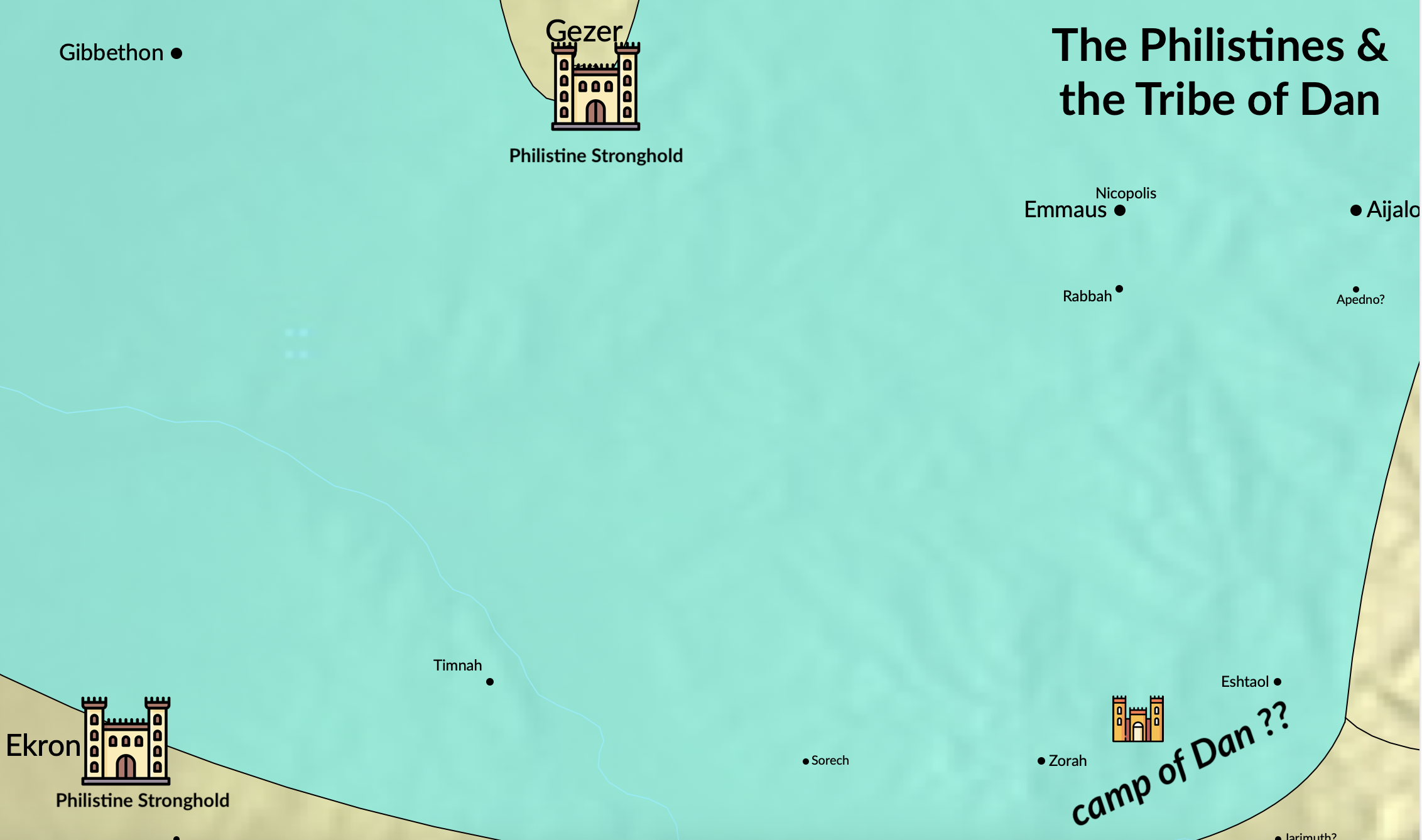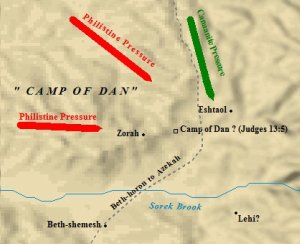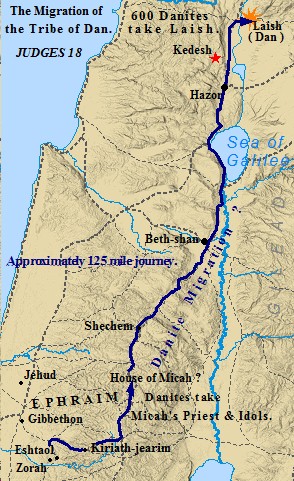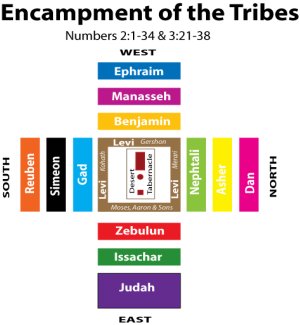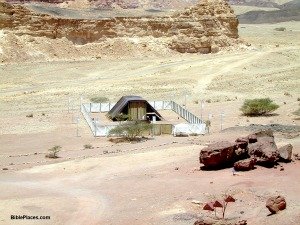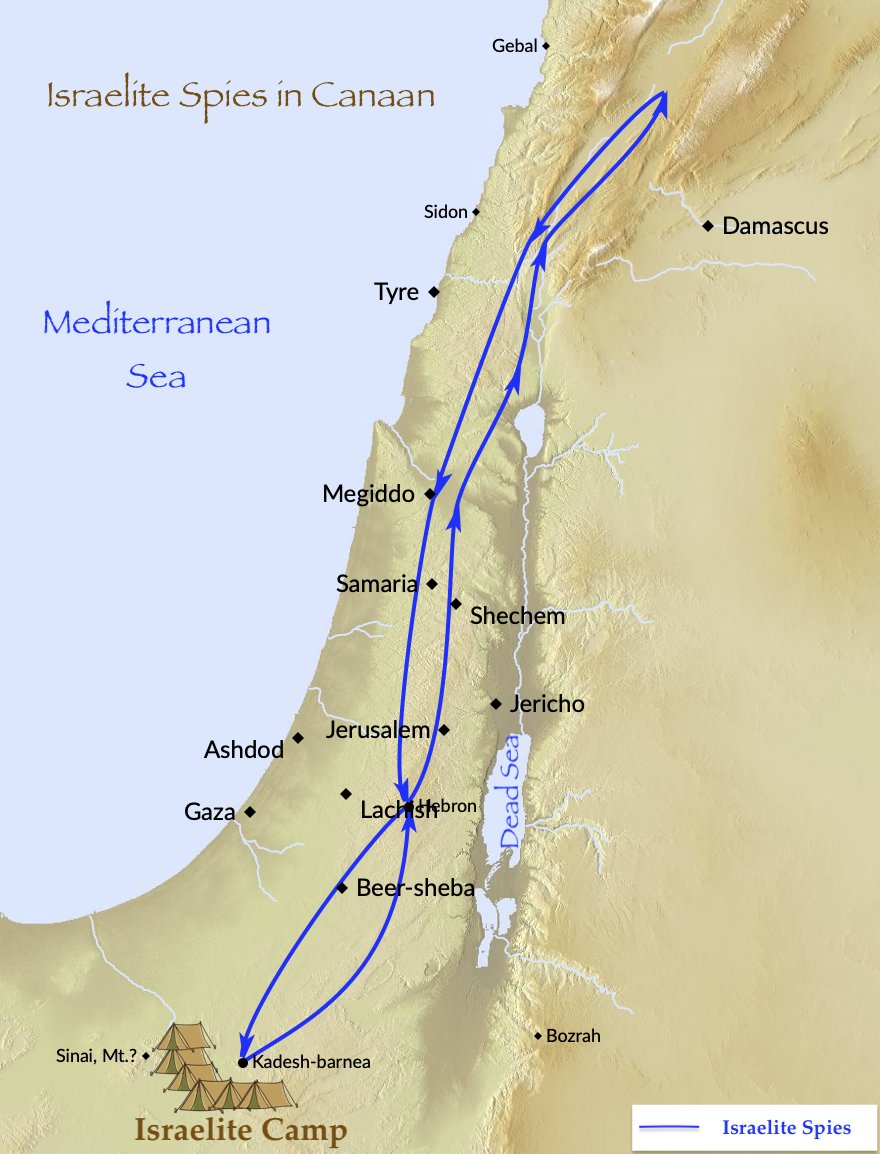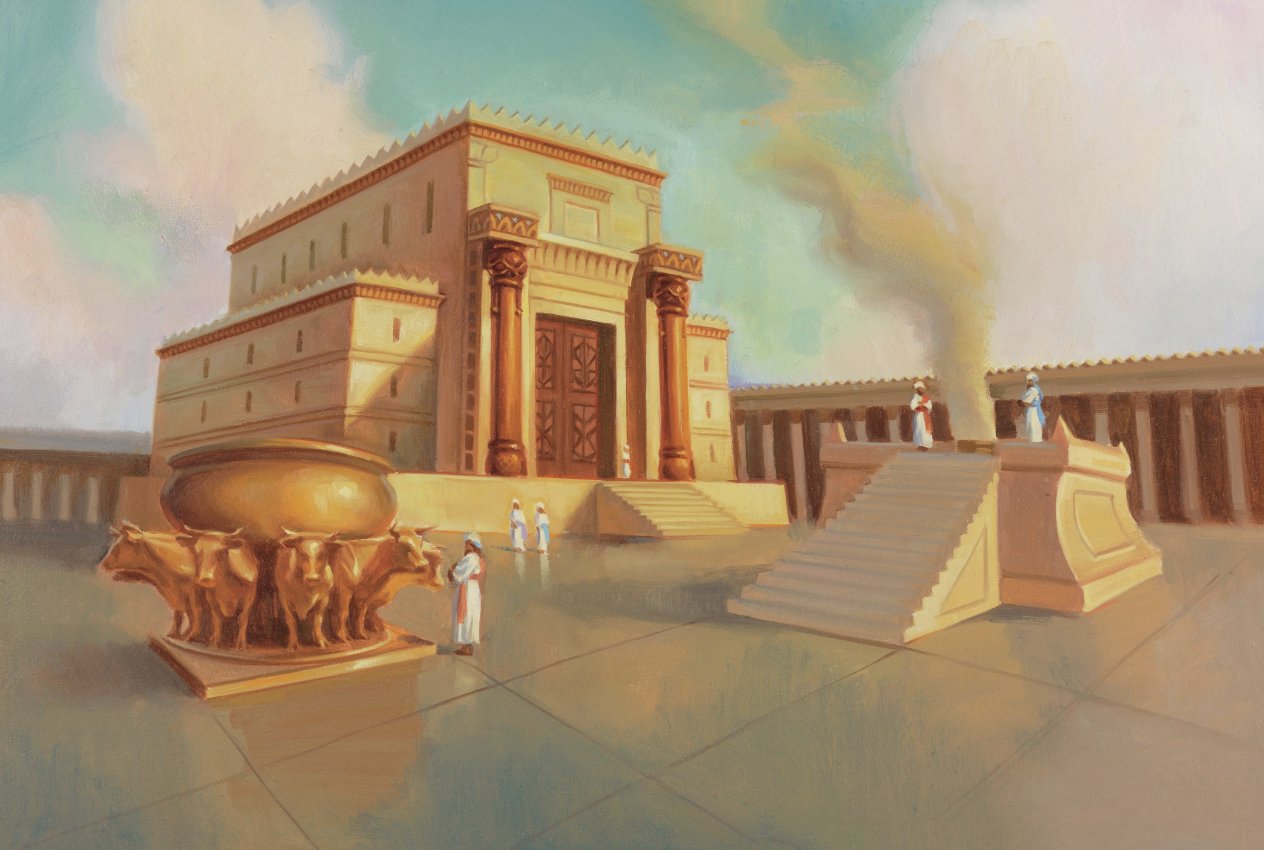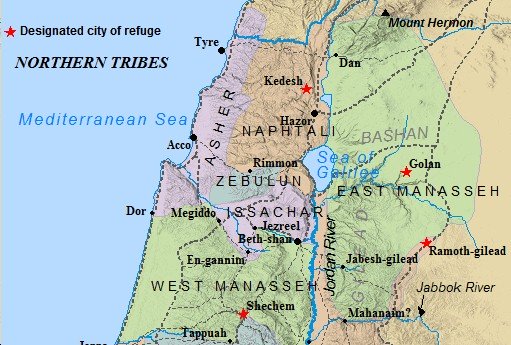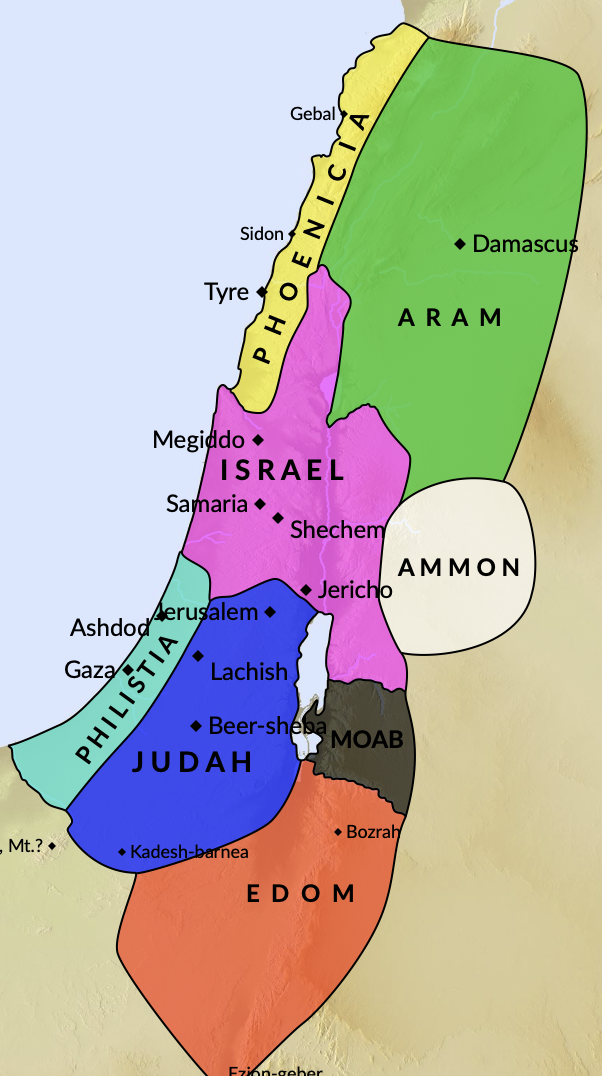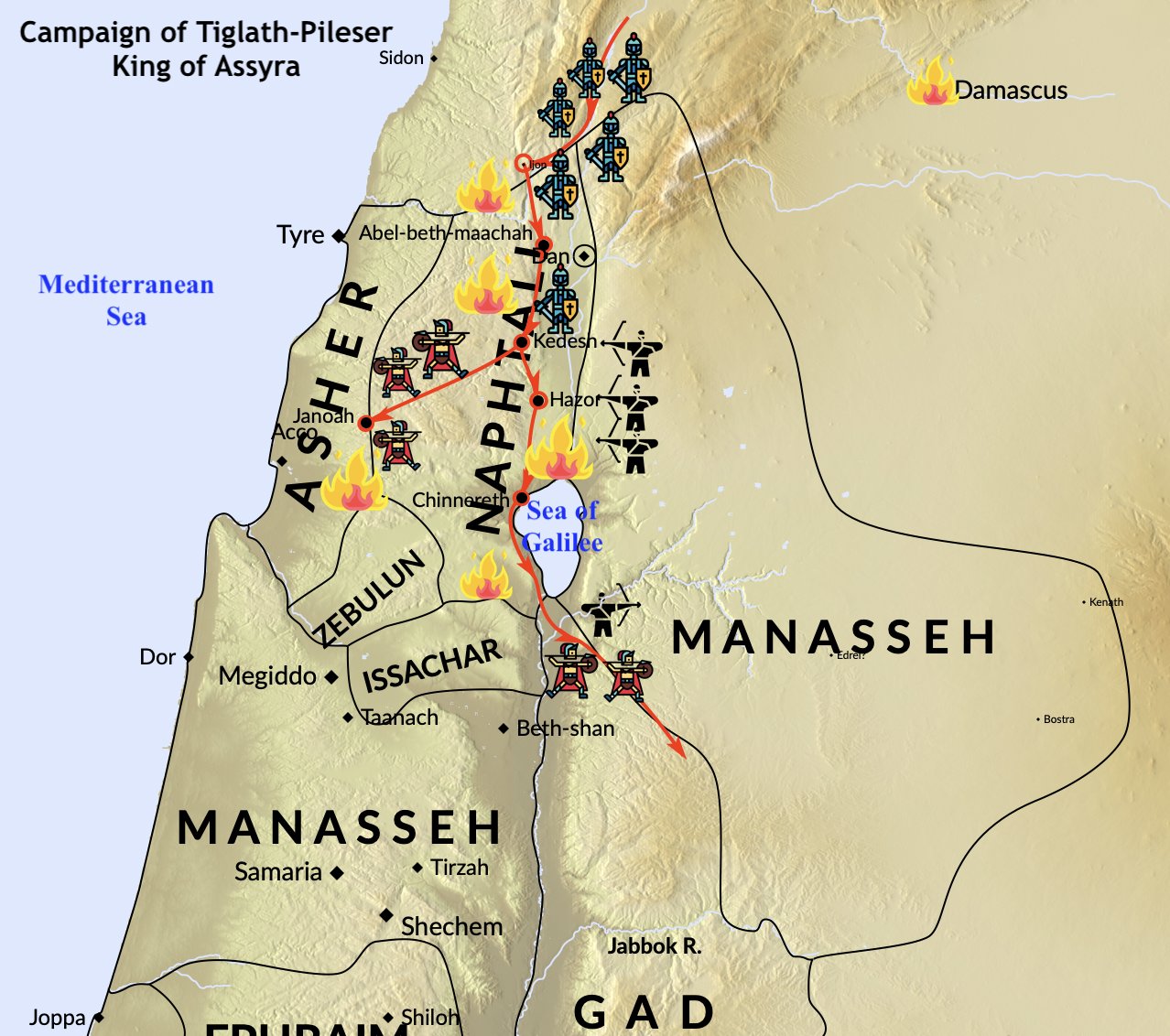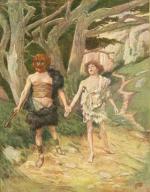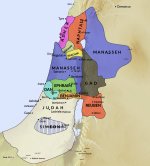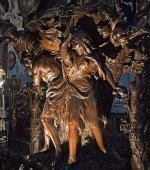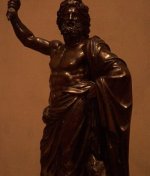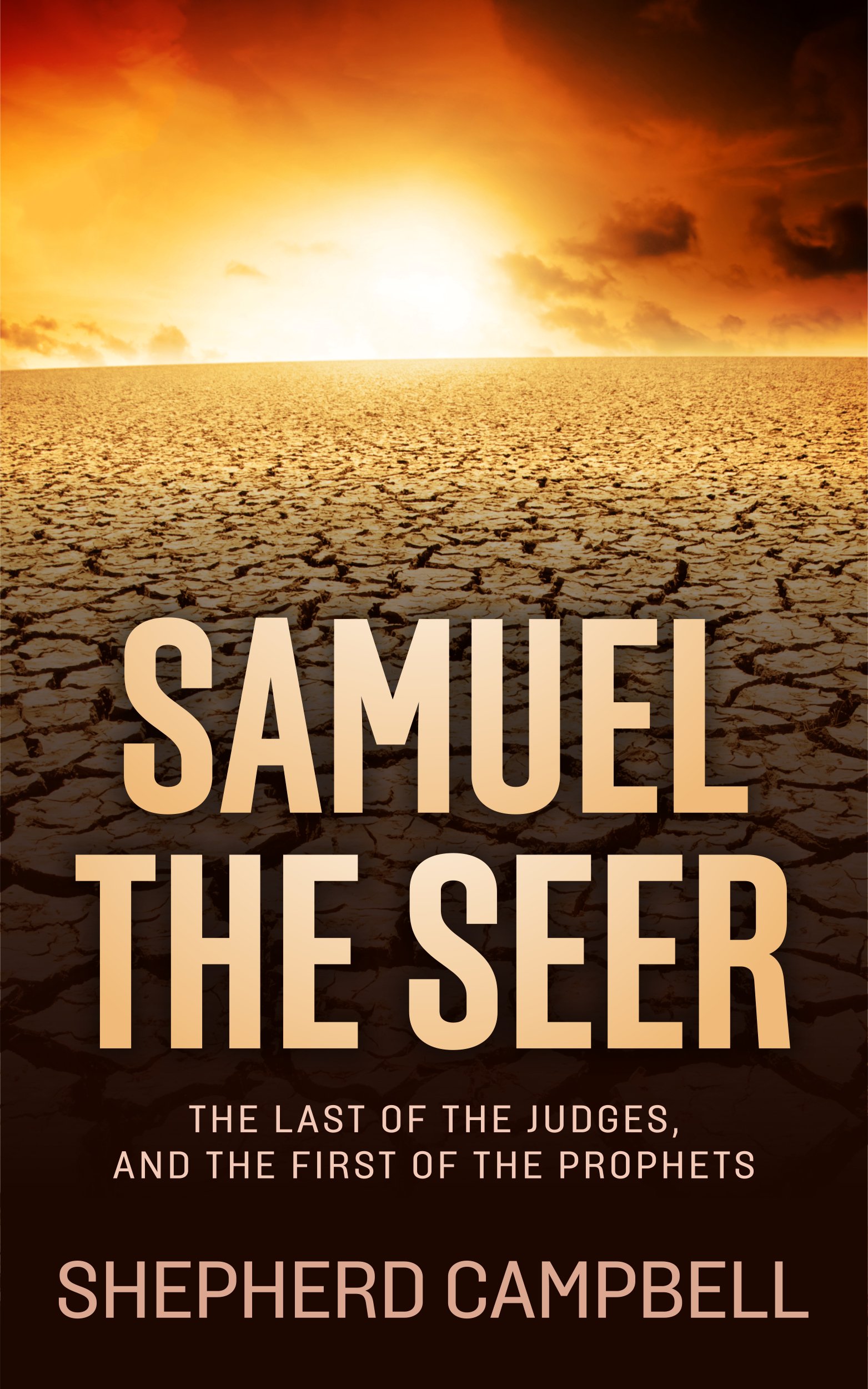- Biblical Maps
- Home Page
- History of Israel Blog
- Ancient Mesopotamia
- Map of Palestine
- Abraham
- Ancient Israel
- 12 Tribes of Israel
- Jerusalem
- The Book of Isaiah
- Palestine
- The Habiru
- Contact Us
- Bible Study Forums
- Media Page
- Visitors Sitemap
- Privacy Policy
- The History of the Old Testament
- In the Days of Noah
- The City of Jericho
VISIT OUR FACEBOOK PAGE!
The Tribe of Dan
The Blessings of the Tribe of Dan
Jacob's Blessing - Gen. 49:16 - 18
"Dan will provide justice for his people as one of the tribes of Israel. Dan will be a serpent by the roadside, a viper along the path, that bites the horse's heels so that its rider tumbles backward. I look for your deliverance O Lord."
Moses' Blessing - Deut. 33:22
"About Dan he said: 'Dan is a lion's cub, springing out of Bashan."
The Tribe of Dan Page Contents
Click on a link to view that section of this page.
Map of 12 Tribes of Israel Boundaries
The Waters of Dan During Enoch
The Northern KingdomThe Tribe of Dan Allotment
The Biblical description "from Dan to Beersheba" came to denote all of the land of Israel, from north to south. Indeed, Dan's meaning in this phrase is twofold. Originally, Dan settled in the southern portion of the land of Canaan, near the Philistine coast.
Later, a portion of the tribe of Dan would migrate to the north, and capture the city of Laish. Due to this migration, Dan is listed as part of the Northern tribes of Israel, along with Asher and Naphtali.
They renamed Laish Dan, after their progenitor, the fourth son of Jacob. The city of Dan became the northernmost limit of the land of Israel.
Thus, Dan was a tribe of the south, and the north; as well as
representing the northernmost limits of Israel itself, with Beersheba
representing the southernmost limits.
The Danites were the last of the tribes in the book of Joshua to receive its allotment. Yet, Nadav Na'aman asserts it is one of the most important tribes in the delineation of the boundary system within the tribes of Israel.
Dan's original allotment, Na'aman further states in his book Ancient Israel and Its Neighbors, was drawn up after the allotments of the tribes of Judah, Benjamin, and Ephraim.
The cities allotted to the tribe of Dan occupy the "territorial gap" (Na'aman 74) left between these three tribes. Na'aman's theory regarding this allotment is self-admittedly "highly conjectural", yet, it would seem to be in accordance with the Biblical account. The chronology of Scripture supports the theory Dan was the last to receive land.
Na'aman states the author of the town list of the Danites, found in Joshua 19:40-48, created Dan's borders after the tribes of Judah, Benjamin, and Ephraim had been allotted land. The tribe of Dan, thus, fell in the gap that existed between these three tribes.
In essence, Na'aman argues this allotment was "an artificial tribal territory". Not artificial in the sense of a false account, as the Bible states the tribe of Dan originally settled in this area, and Na'aman agrees. Artificial, perhaps, in the sense the allotment almost seems an afterthought, as if they had forgot Dan, and simply assigned what was left.
Na'aman's argument centers around the southern border of the kingdom of Ekron in the seventh century B.C. The tribe of Dan neighbored this strong kingdom. In fact, the tribe of Dan settled in the immediate vicinity of the Philistines, of which Ekron was a stronghold.
In the constant battles between the Israelites and the Philistines, the tribe of Dan settled on the very battleground.
The town list of the tribe of Dan appears to be grouped along a
southeast to northwest axis. The first cities listed are found in Joshua 19:41.
"And the territory of their inheritance was Zorah and Eshtaol and Irshemesh."
Irshemesh is also Beth-shemesh. These cities formed the western border of the tribe of Dan. Joshua 19:42 lists the Danites northern border.
"and Shaalabbin and Aijalon and Ithlah,"
Next, Scripture lists the cities of Dan's southeastern border in verse 43.
"and Elon and Timnah and Ekron,"
The ancient city of Ekron was destroyed in the mid-tenth century B.C. This period of decline lasted nearly 250 years, until the seventh century, when Ekron experienced a resurgence. Ekron's archaeological record follows the Biblical account of the conquest, and subsequent events involving this geographical region in regards to the Assyrian invasions of the Old Testament.
The central region of the tribe of Dan is listed in Joshua 19:44.
"and Eltekah and Gibbethon and Baalath,"
Na'aman calls these cities the "mid-west" of the Danite territory. These cities, along with the other western cities of Dan, mentioned below, are very similar to a list of cities found in Sennacherib's Annals. Sennacherib makes mention of Joppa, Bene-berek, Azor, Eltekeh, Timnah, and Ekron.
Gibbethon is also mentioned in Sargon II's reliefs, alongside Ekron. Verses 45 and 46 list the other western cities of the tribe of Dan.
"and Jehud and Bene-berak and Gath-rimmon, and Me-jarkon and Rakkoh, with the territory over against Joppa."
Seven of these cities are listed in Assyrian records, in the form of inscriptions dating to the late eighth century B.C. In 701 B.C. Sennacherib plundered through the Shephelah, razing towns throughout Judah and nearby tribal territories, Dan included.
The tribe of Dan, though situated amongst the southern kingdom of Judah, was considered part of the much larger northern kingdom of Israel. The northern kingdom fell to the Assyrian invaders, while the southern kingdom of Judah lasted nearly two hundred more years.
Much of the population in this region was exiled to Assyria, and many cities were burned and destroyed. The king of Ekron took advantage of the weakened situation and rapidly expanded to the east. Ekron may have enjoyed access to the port in Joppa, and the city prospered under Assyrian rule in the seventh century.
The significance is found in the apparent fact the kingdom of Ekron overlapped into the tribal allotment of Dan in the seventh century B.C. This is the crux of Na'aman's theory regarding the tribe of Dan and their allotment. It would seem the southern border of Dan reflected that of the kingdom of Ekron, and the western portion of Ekron and Dan overlapped.
The tribe of Dan, thus, maintained some sort of presence in the area despite their much earlier migration. Even before the Assyrian push into the Shephelah, the Danites experienced intense pressure from nearby enemies.
The tribe of Dan found themselves settling on the very battle ground involving the Israelite disputes with the powerful and dreaded Philistines. Thus, in Joshua 19:47-48, the tribe of Dan is depicted as searching for a new homeland.
"And the territory of the sons of Dan proceeded beyond them; for the sons of Dan went up and fought with Leshem and captured it. Then they struck it with the edge of the sword and possessed it and settled in it; and they called Leshem Dan after the name of Dan their father."
Leshem is also Laish, also known as Dan. The ancient city, which has been identified as Tell el-Quadi, north of Lake Huleh, which itself lies north of the Sea of Galilee, lies amidst the three principal sources of water for the Jordan River. Nearby Mount Herman towers above the landscape.
It is likely the nearby ancient shrine of Pan was located within the ancient city of Dan. It is near these "waters of Dan", and nearby Mount Herman, that much of the book of Enoch is concerned with. The fallen Watchers of Enoch are said to have descended to the earth from the heavens, touching down on the peak of Mt. Herman.
Regardless, the land has ancient ties to Israel and other cultures. This land, however, was not part of Dan's original allotment.
The tribe of Dan originally settled between the Brook of Sorek and the Yarkon River. However, Philistine cities sliced through the tribal allotment. This pressure would prove too much for the tribe of Dan.
The Philistines were a fierce group of warriors, part of a migratory group known only as the Sea Peoples. They were thought to have originated in the Aegean Sea region. They were the fiercest enemies of Israel. The Philistines terrorized Israel up until the time of David. They captured Samson, as well as the Ark of the Covenant.
Beginning around the eleventh century B.C., the Philistines began
to seek expansion from the coastal plain. They sought control of the
Hill Country.
This inevitably brought them into conflict with Israel. This period is characterized by the Judges of the Old Testament. Samson was a Judge of the tribe of Dan. His enemies were the Philistines.
Fascinatingly enough, the Sea Peoples were a conglomerate of different tribes and ethnicities. Part of this group were the Danuna.
These people are known by a variety of names, including Denyen, Danunites, Danaoi, among others. They have been connected to the tribe of Dan, and the early Mycenaen culture of Greece. Homer's Danaoi are believed by some to be Israelite, at least in part.
These Sea Peoples first attempted to land in Egypt, yet were
repelled. Scholars feel these peole migrated to different parts of the
Mediterranean. The Philistines were one of the tribes which settled in
Canaan, on the coastal strip. It is believed parts of the Danaoi, or
Danuna, settled in Canaan as well.
Without going into too much detail in the current discussion, it is believed by some, such as The Naked Archaeologist Simcha Jacobovici, that part of the tribe of Dan migrated to Mycenae after the crossing of the Red Sea. These people, perhaps, were Homer's Danaoi, and settled nearby native Grecians. Over time the Danaoi intermixed with the Sea Peoples, and participated in their migration from the Aegean region into Egypt and Canaan.
A 3,500 year old tomb was found on Mycenae containing Egptian gold and swords, Israelite in nature. The Grave Stele at Mycenae may depict the actual crossing of the Red Sea, with depictions of a man in a chariot pursuing another man, on foot, and holding what appears to be a staff. This interpretation of the stele, however, is highly debatable, yet fascinating.
THE MYCENAEN GRAVE STELES
3500 Years Old
|
STELE 1 - A man in a pyramid chases another man, holding a staff. The billows on top and bottom may indicate water. Some believe these steles may represent the story of Pharaoh chasing Moses and the Israelites through the Reed Sea. |
STELE 2 - The man in the chariot continues the chase. |
STELE 3 - The man being chased has turned to face his pursuers, holding his staff out in front of him. The man in the chariot has fallen upon disaster, as the billows have crashed down upon him, evidenced by the tangle of bodies, animals and chariots in the stele. |
To digress, the tribe of Dan posed little match for the mighty Philistine warriors. These people were great in size and strength.
Goliath would eventually emerge from nearby Gath to threaten the Israelite army in the time of David. The valley of Elah, the site of this Biblical clash, lie just to the south of Timnah.
The Philistines were the reason the people of Israel would later cry to Samuel for a King to rule over them and to fight for them.
The Philistine strongholds of Joppa, Beth-dagon, and Gezer sliced through the heart of the tribe of Dan, and forced the Danites into a small section of settlement. The Manual of Biblical Geography, written in the early eighteen hundreds, illuminates a passage found in Judges 13:25.
"And the Spirit of the Lord began to stir him in Mahanehdan, between Zorah and Eshtaol."
Mahanehdan translates as "the camp of Dan". Though Scripture does not outright state such, it would seem at this time the Danites occupied virtually none of their promised allotment.
A large tribe in number, the tribe of Dan was allotted a relatively small portion of land. From this portion, they were limited to still a smaller portion of land, driven there and confined by the Philistine presence in the area.
This passage, regarding the birth of the most famous Danite, Samson, alludes to a "camp of Dan", located between the two cities of Zorah and Eshtaol. The implication, one taken in The Manual of Biblical Geography, is that the Danites were confined to this fortified camp and these two cities.
Not only did the tribe of Dan experience pressure from the Philistines, but the opening chapter of the book of Judges indicates the Amorites also fought against Dan. Judges 1:34 illustrates this Amorite pressure.
"Then the Amorites forced the sons of Dan into the hill country, for they did not allow them to come down to the valley,"
The Amorites and Philistines, though originally separate and distinct tribes, eventually merged with each other. Both were formidable foes, dating back to the time of Abraham. The Amorites assisted Abraham in his conquest to rescue Lot.
Later, they drove the Rephaim from Bashan, in the Transjordan. Og, the giant king of Bashan Moses defeated, ruled over the land of the Amorites. The Amorites, thus, came into direct contact with the Nephilim branch of the Rephaim, and later the Philistines.
It seems this camp consisted of these two cities, and some land in between the two cities. Though the exact location of this camp is not given, and the size not measured in Scripture, it would seem natural the camp connected the two cities.
Both of these cities are located in the hill country, just east of the plain occupied by the Philistines and Amorites. The overcrowding was certainly an issue.
Though Scripture does not state, certain conditions were sure to arise as a result of so many in a confined quarter. Though certain Danites very well may have lived outside the confines of this camp, most of the tribe of Dan seems to have dwelt within. Health issues certainly would have arisen, as sanitation decreased, and disease increased.
Thus the closing verses of the town list in Joshua 19 make mention of a group of Danites in search of another homeland. While the tribes of Judah and Simeon were engaged in conquering their allotment, and settling their cities, the tribe of Dan was engaged in a war it could not win.
The Migration of Dan
The narrative concerning the migration of the Danites follows in Scripture the story of Samson. Samson was the fourteenth judge of Israel, and from the tribe of Dan. His birth was mentioned above, recorded in Judges 13:25. Though Samson's death was a heroic one, it seems to end the Danite resistance to the Philistines.
The Song of Deborah, found in Judges 5, indicates that a certain remnant of Dan remained near the original allotment of cities found in Joshua 19.
The depiction of Dan's migration in Judges 18 speaks of a time previous to the Song of Deborah. It is a further development of the brief mention in Joshua 19:47-48 of the Danite migration.
The accusation of Dan in the Song of Deborah is of staying in their ships, and not coming to help the other tribes of Israel engaged in conflict against Jabin, king of Hazor.
"Gilead remained across the Jordan; And why did Dan stay in ships? Asher sat at the seashore, and remained by its landings."
Perhaps their refusal to join in could be traced to their struggle with the Philistines, in which no tribe was mentioned as coming to their aid. Resultingly, a portion of the tribe of Dan set out to seek new land. Judges 18:2 depicts the men of Dan sending out scouts to search for new land.
"So the sons of Dan sent from their family five men out of their whole number, valiant men from Zorah and Eshtaol, to spy out the land and to search it; and they said to them, 'Go, search the land'. And they came to the hill country of Ephraim, to the house of Micah, and lodged there."
Much like Moses did years earlier, the tribe of Dan sent out spies to find a portion of land where they may dwell peacefully, and without Philistine/Amorite threat. As the Mediterranean lie to the immediate west, and the desert region to the south and east, the scouts set out northward.
The spies journey into the hill country of Ephraim, and lodge near the house of Micah. The exact location of Micah's house is not given. However, in the previous chapter we learn of a Levite man who had come to live with Micah, and be his household priest.
Micah had previously made a graven image, and set up a household idol. He hired the priest to oversee these idols. The priest, with nowhere else to go, readily agreed, and moved into Micah's house.
The Danites would have certainly been interested in obtaining a Levite priest to oversee their tribal responsibilities to God. Though Scripture relates this Levite was from Bethlehem, and of the tribe of Judah, the spies from the tribe of Dan recognize the voice of the Levite priest.
"When they were near the house of Micah, they recognized the voice of the young man, the Levite..."
The intent of the Hebrew word translated "recognized" is one of physical apprehension through the use of any one of the senses. What they recognized about the Levite is not said in Scripture.
Perhaps it was simply one of surprise from finding a Levite priest in the home of a man. Perhaps the spies knew of the Levite. Any speculation is just such.
Whatever the reason, the men turned into the Levite, and asked him to inquire of God concerning the success or failure of their journey. The Levite assured them they had the Lord's approval.
The sincerity of the Levite's heart towards God is certainly in question, stemming from his willingness to oversee the idols of Micah.
The spies set out northward once again, and came to the town of Laish. Scripture relates this town was occupied by Sidonians, isolated far from their compatriots located in Sidon, on the coast of Lebanon.
Josephus tells us this was a days journey from Sidon. The Sidonians of Laish were "living in security, after the manner of the Sidonians, quiet and secure".
Scripture makes it clear this city was isolated from any neighbors. The people of this city "had no dealings with anyone". Naturally the Danite spies would have been interested in such a city. Their report back reflects such an attitude, found in verse 9.
"And they said, 'Arise, and let us go up against them; for we have seen the land, and behold, it is very good. And will you sit still? Do not delay to go, to enter, to possess the land.' "
The elders of the tribe of Dan acted on this advice, immediately mustering 600 armed men to carry out the siege. Scripture seems to imply these men set out from Zorah and Eshtaol, before setting up camp at "Mahanehdan", or, the camp of Dan. This camp is located west of Kiriath-jearim.
The 600 armed men sent by Dan to capture the city is very reminiscent of the Habiru bands depicted as waging war on the Canaanites in the Amarna Letters. Marauding bands of men, such as these, are prevalent throughout the Old Testament. In I Kings 11:23-24, Rezon, son of Eliada is said to have fled from his lord Hadadezer, king of Zobah.
Rezon "gathered men to himself, and became leader of a marauding band". This is in exact accordance with the influences which shaped the Habiru bands.
A man flees his homeland, and seeks protection in numbers by forming a band of like individuals. This formula is echoed in the tribe of Dan's migration. Thwarted from occupying their land, driven by enemies into a confined space, they sought safety and security elsewhere. The tribe of Dan, thus, sent out a Habiru-like band of men to find a home.
In like fashion, David led a similar band of discontents before he became king. A number of passages attest to their composition and function. One passage can be found in I Samuel 23:13.
"Then David and his men, about six hundred, arose and departed from Keilah, and they went wherever they could go.."
From the "camp of Dan", the band of armed Danite men marched northward, following the precise route of the spies. The war party next stopped at the house of Micah. The spies had apparently reported the presence of the Levite as well.
It would seem the tribe of Dan planned on obtaining the Levite from Micah, by force if necessary. This priest would serve over the tribe of Dan, in their new homeland.
The armed men of Dan kidnapped Micah's Levite, threatening Micah's life if he should attempt to stop them. Not only do the Danites take the priest, but they confiscated the graven images and idols of Micah's as well.
The Levite, lured by the prospect of becoming High Priest of Dan, readily joined the armed band, quickly dismissing Micah and his household.
Scripture identifies this man as Jonathan, the son of Gershom, the son of Manasseh. The Bible Manual of Biblical Geography calls this Levite a "degenerate grandson of Moses the prophet".
Accompanied by their new priest, and the stolen idols from Micah, the Danites marched on the unsuspecting city of Laish. They struck down all of the people, and burnt the city to the ground. Scripture relates that the people of Laish had "no one to deliver them".
The tribe of Dan rebuilt the city, and named it Dan. The closing verses of Judges 18 portray their re-settlement of Dan.
"And the sons of Dan set up for themselves the graven image; and Jonathan, the son of Gershom, the son of Manasseh, he and his sons were priests to the tribe of the Danites until the day of the captivity of the land. So they set up for themselves Micah's graven image which he had made, all the time that the house of God was in Shiloh."
This would lay the foundation for the Golden Calve Jeroboam would set up in Bethel and Dan. Dan became a cultic center of worship in the northern kingdom, in direct violation of God's commands to Moses.
King Jeroboam made two golden calves, recorded in . He placed one in Bethel and the other in Dan, echoing the words of Aaron in the wilderness, when the tribes urged him to make a golden calve for them to worship.
"behold your gods, O Israel, that brought you up from the land of Egypt."
The migration of the tribe of Dan was complete with their capture of Laish, and subsequent resettlement and renaming of the city to Dan. However, as noted earlier, not all of the tribe of Dan migrated northward.
The Song of Deborah implies a remnant remained still in the native allotment, though this is not explicitly stated in Scripture.
The Tribe of Dan Encampment
As Moses and the Israelites wandered in the wilderness, God gave them specific instructions on how to organize their camp. The encampment of the Israelites was centered around the Tent of Meeting and the Tabernacle. This was placed in the center of the camp, symbolic of God taking center precedence in the hearts of the Israelite tribes.
Specific instructions were given to Moses in Numbers 2 as to the arrangement of the camps. Numbers 2:255-31 is God's instructions concerning the tribe of Dan.
" On the north side shall be the standard of the camp of Dan by their armies, and the leader of the sons of Dan: Ahiezer the son of Ammishaddai, and his army, even their numbered men, 62,700."
The tribe of Dan, thus, was to be the leading tribe encamped on the northern side of the Tabernacle. Following the Danites in camp was the tribe of Asher, followed by the tribe of Naphtali. Numbers 2:31 summarizes the camp of Dan.
"The total of the numbered men of the camp of Dan, was 157,600. They shall set out last by their standards."
This was the second largest of the four tribal encampments around the Tabernacle. The tribe of Judah possessed the largest camp, numbering 186,400. As the Israelites broke camp, the tribe of Dan would lead the northern tribes out of camp last, following after the camp of Ephraim.
The marching order of the tribes is as follows: The tribe of Judah, leading the tribes of Issachar and Zebulun, broke camp first. They were followed by the camp of Reuben, leading the tribes of Simeon and Gad.
Thirdly came the camp of Ephraim, leading the tribes of Manasseh and Benjamin as well. Lastly, the fourth to break camp, was the camp of Dan, leading the tribes of Asher and Naphtali.
Dan
The tribe of Dan seems to be somewhat of an aloof and isolated tribe in relation to the other tribes of Israel. This may be backed up by their isolated homeland, in the northernmost extremity of the land.
It can also be seen in their lack of participation pointed out by Deborah. Perhaps this seemingly aloof stance may be traced back to the birth of Dan, the fifth son of Jacob. Dan's birth is recorded in Genesis 30:1-6.
The previous four sons of Jacob had been born by Leah. Genesis 30 opens up with an interesting encounter between Jacob and Rachel. Rachel, seeing the birth of four sons to Leah, had yet to produce a son for Jacob.
She most certainly was becoming jealous, as Scripture relates, and feared her place in the family may be jeopardized due to her lack of production.
"Now when Rachel saw that she bore Jacob no children, she became jealous of her sister; and she said to Jacob, 'Give me children, or else I die."
Rachel's outburst appears irrational. For it is not Jacob that has failed to produce children, but rather she is incapable, thus far, of producing children. Jacob became angry at Rachel's outburst, and responds in like fashion in verse 2.
"Then Jacob's anger burned against Rachel, and he said, 'Am I in the place of God, who has withheld from you the fruit of the womb?' "
Rachel's solution finds precedent in Sarai giving her handmaiden Hagar to Abraham. Rachel gives Jacob Bilhah, her handmaiden, to sleep with. Upon sleeping with Jacob, Bilhah conceived a son.
"Then Rachel said, 'God has vindicated me, and has indeed heard my voice and has given me a son.' Therefore she named him Dan."
The name Dan translates as "judge", "to minister judgment", and "to plead a cause". Rachel had pleaded her cause to God, and God had answered by giving her Dan. Dan's name would be echoed in the prophecy of Jacob. The tribe of Dan was to rule themselves as a tribe of Israel.
They were to judge their own house. This prophecy was fulfilled when the Danites migrated north, carrying a Levite priest of their own. Their isolation from the other tribes would have led to a more self-contained and self-sufficient tribe than some of their brethren.
It would seem natural that the child Dan did not feel as an equal growing up. His four older brothers all shared the same birth mother, Leah. Dan, thus, at times surely felt like an outcast, the only son of the handmaiden Bilhah.
Bilhah soon conceived another son, named Naphtali. Dan, seemingly, would have migrated to this brother much more than the other four brothers.
Though this is conjectural, it does seem natural Dan would have been closer to his natural brother growing up, more so than his four older brothers from a different mother. Naphtali's membership in the camp of Dan would seem to agree with this notion. The two tribes, like the two brothers, were close to each other over the course of their early years.
No exploits of Dan are given in Scripture. His role is not nearly as prominent as the other sons of Jacob, namely Simeon, Judah and Joseph.
He garnered no favoritism from Jacob, as Benjamin did in the later stages of the narrative. There are no sections of Scripture pertaining to him, as is the case with Judah and Tamar. He is not mentioned in the rape of Dinah, as Levi and Simeon are the only brothers mentioned by name.
An interesting passage in Genesis 37 may shed some light on the nature of Dan in his early years. This passage is found in Genesis 37:2.
"Joseph, when seventeen years of age, was pasturing the flock with his brothers while he was still a youth, along with the sons of Bilhah and the sons of Zilpah, his father's wives. And Joseph brought back a bad report about them to their father."
This passage seems to imply that Joseph, along with the sons of Bilhah and Zilpah, were tending the flocks of Jacob. Whether the other sons of Jacob were present or not may or may not be gleaned from this passage.
Though it does state he was pasturing the flocks "with his brothers", Scripture plainly identifies the sons of Bilhah and Zilpah.
Joseph's bad report immediately follows the listing of the two handmaidens. This would seem to imply it was specifically the sons of Bilhah and Zilpah Joseph reported on.
Following this line of thought, which is purely theoretical as Scripture does not specifically state who was or was not present, would mean that Joseph, Dan, Naphtali, Gad, and Asher were out tending the flocks.
Perhaps the other sons were present, perhaps they were occupied with other flocks or business. What is known for sure is that the sons of Bilhah and Zilpah were present, along with Joseph.
The Hebrew word translated as "bad" is "Ra". This word means "evil", "distress", "misery", "injury", and "calamity". Scripture does not specify as to what Dan and his brothers were doing, only that it was not right, and Joseph reported their actions to Jacob.
Thus Dan and his brothers were involved in something that went against the commands of God, and would be displeasing to their father Jacob as well.
This "bad report" would not have lent Joseph to their affections. Not only did the sons of Bilhah and Zilpah dislike Joseph, but Scripture plainly states all of the sons of Jacob disliked him, and wanted to rid themselves of him. Thus, by implication, Dan was surely part of the initial plot to kill Joseph.
Genesis 42:3 indicates Dan was one of the sons of Jacob that went initially to Egypt in search of grain. This passage makes it evident that only Benjamin stayed behind, with the other ten sons setting out on the journey. However, throughout the narrative concerning Joseph the name of Dan is never mentioned.
Though he was present throughout the ordeal, his role in the family was one of deference to the more prominent sons. In the narrative of Joseph, it is Reuben, Judah, and Benjamin that play prominent roles. Scripture is silent concerning the thoughts, words, and actions of the other sons of Jacob.
In the waning chapters of the book of Genesis, Jacob and his family move to Egypt, reuniting with Joseph, and fleeing the current famine in Canaan. Among the sons of Jacob departing for Egypt is Dan. Genesis 46:23 lists the family of Dan migrating into Egypt.
"And the sons of Dan: Hushim."
This is the only son of Dan mentioned as migrating into Egypt with his father and grandfather. Whether Dan had other sons, which seems probable, is not stated in Scripture. Perhaps this was the only son he had at the time of the migration, thus the only son Scripture felt obligated to mention.
In any case, the son of Dan is mentioned again in Numbers 26:42.
"These are the sons of Dan according to their families: of Shuham, the family of the Shuhamites. These are the families of Dan according to their families. All the families of the Shuhamites, according to those who were numbered of them, were 64,400."
Though the names are different, they speak of the same person. The numbers of Dan were up in this second census, taken in the book of Numbers two chapters before Moses' death and Joshua's ascension to leadership.
The first census taken is recorded in Numbers 1:38, as the Israelites awaited further instruction in Sinai.
"From the descendants of Dan: All the men twenty years old or more who were able to serve in the army were listed by name, according to the records of their clans and families. The number from the tribe of Dan was 62,700."
Thus, the tribe of Dan increased by nearly two thousand men throughout the 40 year wandering.
The Tribe of Dan
Though the Bible is silent about Dan's individual exploits, it gives many details concerning the tribe of Dan, and different individuals within this tribe. Many prominent men, none moreso than Samson, originated from this tribe.
The tribe of Dan, though perhaps exalted to some degree in the wilderness, would take on a dubious role later in the northern kingdom of Israel.
The first encounter of the tribe of Dan in Scripture takes place in Exodus 31:6. The Danites take on special significance due to the nature of this passage. God had previously been instructing Moses on how to build and organize His Tabernalce and the Tent of Meeting.
In the opening verses of Exodus 31 God assigns certain craftsmen to make artistic designs with gold, silver and bronze, as well as to cut stones and wood for construction. He mentions two specific men to Moses. One is Bezalel, the son of Uri of the tribe of Judah.
The second man mentioned is Oholiab, the son of Ahisamach of the tribe of Dan. These men, according to God, are to "make all that I have commanded".
Exodus 31:7 mentions specific projects this representative from the tribe of Dan would be responsible for.
"the tent of meeting, and the ark of testimony, and the mercy seat upon it, and all the furniture of the tent."
This would have been a great honor for Oholiab, and the tribe of Dan as well. They were partly responsible for the construction of Israel's most holiest objects, as well as the Temple in the wilderness.
Nothing God does with the Israelites is random. Why He chose this man from the tribe of Dan is not stated, yet, it reflects positively on the tribe itself.
However, Dan's next appearance in Scripture deals with an apparent unsavory Danite. This episode takes place in Leviticus 24:10-16, as the Israelites wandered in the desert, and is much less flattering toward the tribe of Dan. In this passage, an unnamed "son of an Israelite woman, whose father was an Egyptian" got into a dispute with another Israelite, also unnamed.
The son of this Israelite woman, whose name is given as Shelomith in verse 11, the daughter of Dibri, of the tribe of Dan, "blasphemed the Name and cursed".
This immediately drew the attention of Moses. The Danite man was placed in custody. God instructed Moses to lead the man outside of camp, and to instruct all who heard the curse to lay their hands on his head. Next, God instructs "all the congregation" to stone him to death.
This episode led Moses to declare all who blaspheme the Name, "The alien as well as the native", to be put to death. Interestingly, the tribe of Dan is depicted as intermarrying Egyptians while enslaved in Egypt.
This connection with outside civilizations would be re-enforced by later references to the tribe of Dan in Scripture, as will be seen.
Numbers 1 gives the name of the man God elected from the tribe of Dan to stand with Moses, and to represent the tribe of Dan before him. This man's name is Ahiezer, the son of Amishaddai. This man, along with the eleven other chosen representatives from each tribe, were the leaders of Israel in the wilderness.
"These are they who were called of the congregation, the leaders of their father's tribes, they were the heads of divisions of Israel." -- Numbers 1:16
As the Israelites drew closer to Canaan, Moses sent out spies to scout out the land, recorded in Numbers 13. One man was chosen from each of the twelve tribes of Israel.
From the tribe of Dan, Ammiel, the son of Gemalli was chosen. Further insight may be garnered by analyzing the report given by the spies to Moses.
The only spy proving faithful to God was Caleb, from the tribe of Judah. The other eleven spies reported back they were not capable of taking the land, as the inhabitants were much stronger and larger than they. Ammiel's report, by implication, followed this train of thought.
Thus, the spy from the tribe of Dan lacked faith in God, and demonstrated this lack of faith by advocating the Canaanites were too strong and numerous to overtake. Only Caleb responded in faith, and he and his tribe were duly rewarded by God in the conquest.
Perhaps the lack of faith on Ammiel's part played a role in their inability to drive out the Philistines, just as Caleb's faith played a role in his ability to conquer his allotment. Perhaps it was an indication of the overall state of faith found within the tribe of Dan.
Thus far, two Biblical incidents involve Danites exhibiting a lack of faith and concern for the commands of God.
However, throughout the reigns of David and Solomon, the tribe of Dan made significant contributions to each king. At the beginning of the reign of David, he summoned men to Hebron, "to turn the kingdom of Saul to him, according to the word of the Lord".
I Chronicles 12:35 lists the tribe of Dan as providing David with 28,600 fighting men. Azarel, the son of Jeroham, of the tribe of Dan, became one of the Chief Officers of the tribes of Israel under David's reign. Scripture calls these men "princes of the tribes of Israel" in I Chronicles 27:22.
A fascinating association is made with the tribe of Dan during the reign of Solomon. Solomon, in his efforts to build the Temple, solicited Hiram, king of Tyre, for help in obtaining labor and resources.
Hiram responds in kind to Solomon's request. His response is recorded in II Chronicles 2:11-18. Verses 13 and 14 shed an invaluable light on the situation regarding the tribe of Dan right before the fall of the United Monarchy.
"And now I am sending a skilled man, endowed with understanding, Huram-abi, the son of a Danite woman and a Tyrian father, who knows how to work in gold, silver, bronze, iron, stone and wood, and in purple, violet, linen and crimson fabrics, and who knows how to make all kinds of engravings and to execute any design which may be assigned to him, to work with your skilled men, and with those of my lord, David your father."
The obvious implication of this passage is that some members of the tribe of Dan had migrated northward, into Tyre and Sidon, and intermarried with the local Phoenicians. It is no coincidence Israel's closest allies throughout the Old Testament were the Phoenicians.
They regularly traded with them, and sought their help in building the Temple and the resources needed to build the Temple. This passage makes it evident the tribe of Dan had integrated themselves, to a certain degree, with the Phoenicians of Lebanon. They had intermarried, and likely adopted come customs and practices of these people.
Phoenicians are connected to the Greeks as well, thus, strengthening the possible connection between the tribe of Dan and Mycenae culture. The tribe of Dan were seafarers, made evident by the Song of Deborah. This seems at odds with the nomadic and pastural tendencies of the other tribes of Israel.
However, when taken into context with the association with the Phoenicians, it makes more sense. The Phoenicians were the greatest seafarers of the ancient world. They colonized areas throughout all of the ancient world, including North Africa and parts of Britain.
The tribe of Dan easily integrated itself with this powerful nation. If one remembers, it is believed by some that part of the Danites migrated to Greek before the Exodus.
If this were so, then a relationship between the Danites and their northern neighbors in Lebanon may have been in existence for quite some time. If this were the case, then an integration into Phoenician culture may not seem unlikely at all, but rather a reunion of sorts.
Though all of the tribe of Dan did not integrate, parts did. However, the above theory should be taken as purely theoretical, seeing how the Bible is silent about such matters.
This is further evidence of the aloofness Dan seemed to possess in relation to the other tribes. Repeatedly, throughout Scripture, Dan is reaffirmed as being a tribe of Israel. First in Jacob's prophecy, then in their re-naming of the city Dan, after Dan, their father".
Perhaps this insistence to associate themselves with Israel may have been due to the fact Dan, more so than any of the other tribes, integrated itself more readily into other cultures.
The merging of Dan and Tyre opens up all kinds of possibilities and theories, all of which are purely theoretical, as Scripture is silent concerning Dan after the fall of the northern kingdom. However, it cannot be denied that Dan was associated with Tyre, and the Phoenician culture, as evident in the passage above.
Soon after the fall of Solomon, Israel split into two kingdoms, the southern kingdom, centered in Jerusalem , and the northern kingdom, centered in Samaria and Shechem initially.
Dan in the Northern Kingdom
It was during the time of the Divided Monarchy the tribe of Dan began to stray from the teachings of the true God Almighty. The precedence for their idolatry is found in their initial migration northward.
After stealing the idols from Micah's house, they set these very idols up to worship for themselves, under the guidance of an equally wayward and misguided Levite priest.
Thus the seed of idolatry was laid within the tribe of Dan from the earliest stages. This,coupled with their proximity to foreign influences and threats, and their isolation from the rest of the tribes of Israel, surely played an integral role in their assimilation with Tyre and association with idolatry.
This idolatrous tendency fully revealed itself during the reign of King Jeroboam I. With the death of Solomon, Jeroboam rose to lead the northern kingdom of Israel, while Rehoboam became the first king of Judah. I Kings states Jeroboam built up Shechem as his capital.
He quickly became worried about losing spiritual face to the southern kingdom of Judah, headquartered in Jerusalem, the heart and soul of Israelite life and religion. He feels that if the people continue to go to Jerusalem to worship, they will turn on him in favor of Rehoboam.
Jeroboam is said to have consulted his advisers as to a solution to this potential problem in I Kings 12:28-30.
"So the king consulted, and made two golden calves, and he said to them, 'It is too much for you to go up to Jerusalem; behold your gods, O Israel, that brought you up from the land of Egypt.' And he set one in Bethel, and the other he put in Dan. Now this thing became a sin, for the people went to worship before the one as far as Dan."
As stated above, these were the words Aaron offered to the Israelites when Moses would not come down from Mt. Sinai in Exodus. Jeroboam plays on these emotional words, surely known by the Israelites as the words of Aaron. The Bible states this became a sin in the eyes of God, as people traveled as far as Dan to worship these golden calves.
Jeroboam set the precedent for the wayward religious practices of the northern kingdom. Dan was more than willing to accept their role, as they had been practicing idolatry seemingly since they left their original allotment, perhaps as much as two centuries earlier.
The tribe of Dan, thus, did judge over Israel as one of its own tribes. They became a cultic center of worship, the symbol of the northern kingdom's religious deviance.
Other Israelite kings, such as Ahab, strengthened Dan's idolatrous stance. Ahab and his father Omri were strict adherents to a policy of combining Canaanite and Israelite religions, and Dan was the center of this worship.
Ahab seems to have been the king responsible for expanding the high place at Dan. Later, Ahab prostrated himself before Baal, in the temple of Baal he erected in Samaria. Further Phoenician ties can be found in Ahab's wife, Jezebel, who was a Phoenician herself.
The tribe of Dan's involvement in these pagan practices drew harsh criticism from the prophets of this time. Jeremiah prophecied against the Danites in Jeremiah 8:16-17.
"From Dan is heard the snorting of his horses; at the sound of the neighing of his stallions the whole land quakes; For they come and devour the land and its fulness, the city and its inhabitants. 'For behold, I am sending a serpent against you, Adders, for which there is no charm, and they will bite you,' declares the Lord."
This is reminiscent of Jacob's prophecy concerning Dan, and the viper along its path which bites the horses heal. The prophet Ezekiel promises the downfall of Tyre in Ezekiel 27.
This passage makes reference to "Vedan", and "Dedan", some associate with the tribe of Dan. Regardless, Ezekiel forsees the downfall of Tyre, a known associate of Dan's.
Perhaps the harshest prophecy regarding the tribe of Dan is found in Amos 8:14. In this passage, Amos predicts the downfall of Dan, and further adds they will not rise again.
"As for those who swear by the guilt of Samaria, who say, 'As your god lives, O Dan.' And, 'As the way of Beersheba lives,' They will fall and not rise again."
CONCLUSION
It is quite clear the tribe of Dan quickly fell into idolatry and pagan religious beliefs and practices. Their transgression did not go unnoticed. It is interesting to take notice of the only list concerning the 12 tribes of Israel found in the New Testament. This list is found in Revelation 7.
The passage in Revelation is concerned with the Remnant of Israel. These people are the ones sealed by God. They number 144,000 individuals. This number is reached by taking twelve thousand people from each of the twelve tribes of Israel. However, the tribe of Dan is excluded from this list!
Scripture gives no reason for their absence. Any reason as to why is speculation and conjecture. What is clear is that the tribe of Dan was to suffer the same fate as their northern compatriots.
The Assyrian king Tiglath-pillesar ravaged the northern kingdom first, exiling the members of the tribes of Reuben, Gad and Manasseh. He captured the territory of Naphtali, and certain cities in Ephraim.
A large number of civilians were exiled. Sargon II later completed the full destruction of the northern kingdom of Israel.
The tribe of Dan, though not mentioned by name, surely fell victim to these conquests. There are a number of scholars who feel perhaps Dan fled the area beforehand, and migrated westward, perhaps crossing the Mediterranean.
What the Bible does make clear is that the northern tribes were no more. The tribe of Dan, along with the other northern tribes of the kingdom of Israel, fell at the hands of the Assyrians.
A looming passage in Deuteronomy 29 may supply a reason for the tribe of Dan not being mentioned in Revelation.
Moses is addressing the people, and warns of what will happen should they forsake God, and pursue false idols and gods.
"The Lord shall never be willing to forgive him, but rather the anger of the Lord and His jealousy will burn against that man, and every curse which is written in this book will rest on him, and the Lord will blot out his name from under heaven."
The tribe of Dan had sinned against God by setting themselves up as a city of pagan worship and idolatry. They had led astray untold numbers of Israelites, and had rivaled the true Temple in Jerusalem by erecting false idols, golden calves, and possessing high places of worship to foreign gods.
A member of the tribe had blasphemed the Name in the wilderness, and this trend was continued by the tribe of Dan itself after the division of the kingdom. This passage in Deuteronomy may provide insight into why the tribe of Dan was left off the list of twelve tribes found in Revelation.
Perhaps their willingness to intermingle with the nations, and their readiness to accept Micah's idols, and later Jeroboam's golden calve, led to their exclusion from the list in Revelation.
However, it should not be lost that this tribe also helped construct the the Tent of Meeting, and Solomon's Temple. They came to the support of king David when he needed men. This enigmatic tribe possesses an intriguing history, surrounded by their mysterious absence in Revelation.
The tribe of Dan, more than any other, has been credited as being one of the lost tribes responsible for the settlers of Great Britain and America.
Though they are a suspect tribe of Israel, often mingling with other nations and idolatry, the tribe of Dan has captured the fascination of scholars and experts seeking to reconstruct the migration of the lost tribes of Israel. Dan has been associated with Homer and the Greeks, as well as Britain and the America's.
"The Mysterious Tribe of Dan" - hope of israel.org
Back to the Tribe of Dan
Back to the Home Page
Back to the 12 Tribes of Israel
Recent Articles
-
The History of Ancient Israel
Dec 25, 23 02:16 PM
An easy to read history of ancient Israel from Old Testament times to today. -
The Ancient City of Jericho
Dec 18, 23 11:21 PM
The city of Jericho is one of the most ancient cities on earth. The city played a crucial role in a number of Bible stories. -
Story of Cain and Abel
Dec 17, 23 01:20 PM
The story of Cain and Abel is a tragic story of jealousy, rage and fratricide. It is the first murder in recorded history. -
The Twelve Tribes of Israel
Dec 17, 23 12:13 AM
The twelve tribes of Israel originated with the twelve sons of Jacob. -
The Tribe of Gad
Dec 16, 23 11:54 PM
The Tribe of Gad was a fierce tribe that participated in many of Israel's battles. They settled land east of the Jordan River. -
Life of Adam and Eve
Dec 11, 23 10:50 PM
The life of Adam and Eve was a blessed life meant to be lived eternally in Paradise. They lost Paradise, and ever since man has been looking for Eden. -
In the Days of Noah
Dec 11, 23 10:05 PM
Jesus stated that in the last days it will be as in the days of Noah. The days of Noah were some of the strangest the world has ever seen. -
The Nephilim
Dec 11, 23 12:05 AM
Were the Nephilim byproducts of fallen angels and women? Enoch wrote it was so, as did Moses. What mysteries lie buried in the pages of the Old Testament?
SAMUEL the SEER
Now Available in Print & eBook on Amazon!!
POPULAR TOPICS
Learn more about these popular topics below. The Bible is full of fascinating stories, characters and mysteries!
BIBLE MAPS
Explore the land of the Old Testament! View these maps of the Bible.
